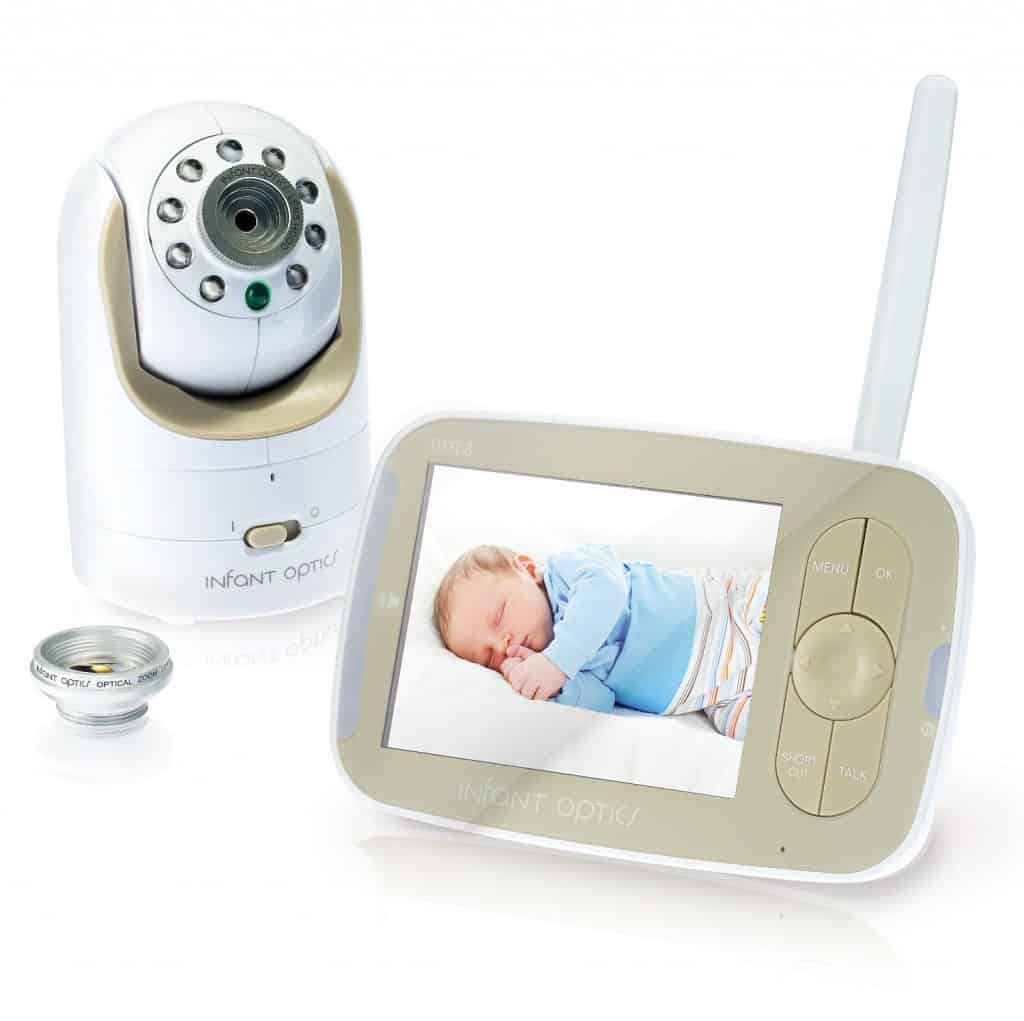
The Best High-End Video Baby Monitors 2025
Best High-End Video Baby Monitors 2025
Last Updated: . After researching and reviewing 16 different video monitor brands, we pick the Infant Optics DXR-8 as the Best High-End Video Baby Monitor 2025.
Scroll down for our picks for Best Streaming Video Baby Monitor, Best Fixed Camera Video Baby Monitor.
New to Video Monitor shopping? Read our 7 Things No One Tells You About Buying a Video Baby Monitor for advice and tips.
The Infant Optics features crisp 3.5″ screen, two-way talk and interchangeable lenses, which is unique among baby monitors. Scroll down to read more about the brand and the DXR-8 model.
The Best Video Baby Monitor
Infant Optics DXR-8
The Infant Optics DXR-8 combines the key features you need in a video monitor—point-tilt-zoom, interchangeable lens, decent picture, good battery life, sound-only night mode, and sharp night vision—for an affordable price.
More details on the Infant Optics DXR-8 Video Monitor
Infant Optics sells just one type of product—video baby monitors. And don’t go looking for these monitors in stores—Infant Optics mostly sells its monitors online (most notably, Amazon). Founded in 2010, Infant Optics is part of San Francisco-based importer Genexus.
Infant Optics debuted its first baby monitor in 2012 (the fixed camera DXR-5). The PTZ monitor (DXR-8) debuted in 2014. As of this writing, Infant Optics only has these two models.
Infant Optics best-selling model is the DXR-8—this $152.99 $143.99 unit has pan/tilt/zoom and interchangeable lenses (the normal and zoom lense come in the box; wide angle is sold separately). The swappable lenses are unique and you might think, at first blush, what is the point? Why would you need to swap the normal angle lens with a zoom?
After playing around with this monitor for while, the most obvious answer is ease of installation. Depending on the configuration of your nursery, your only option may be to put the camera on a dresser across from the crib—then the normal lens might do. But if you mount the camera on a wall above the crib, the zoom lens might be better. (Always make sure cords are at least three feet from the crib). Side note: The VuSee is an affordable corner-mount ($16.99 ) that enables wall mounting of this monitor above a crib.
Most folks repurpose a baby monitor later to monitor a toddler’s room or play area—then the wide angle lens ($11.98 , sold separately) might be the better bet. Of course, interchangeable lens means you might also lose the lenses (at least, that’s what would happen to us)— but you can buy replacements from Infant Optics’ website.
Beyond the standard intercom and temperature sensor features (common on many monitors in this price point), we also liked the Infant Optics screen off, audio-only mode which is most useful during overnight hours. Infant Optics estimates the battery life at six hours (when the screen is turned on)—our research says that is relatively accurate. Obviously, it would make most sense to have the parent monitor plugged in (instead of using battery power) overnight, but the audio-only mode should get you through the night on a fully charged battery if you forget.
One nice feature: you can recharge the lithium-ion battery in the parent unit with any USB plug—computer, USB power cube, etc.:
Need to monitor twins? Or quads? The Infant Optics DXR-8 lets you link up to four cameras to a single display, which will then cycle through the additional cameras every 12 seconds.
Night vision on the DXR-8 is impressive: here’s how it looks compared to a similar Samsung monitor (on left). The DXR-8 had an overall crisper and brighter picture when using night vision:
How’s the range? The Infant Optics DXR-8 uses 2.4 Ghz technology—that provides secure transmission (the parent unit is paired with the camera) to prevent eavesdropping. The company claims a range of 700 feet line of sight. Real world tests indicate it works well in two or even three story homes, with few dropouts, say readers.
Flaws but not deal breakers
To Infant Optics credit, the company has tweaked the monitor over the years to address user complaints. Example: there used to be an audible beep when the monitor went into sleep mode or low battery—that obviously drove folks crazy at 2am. So Infant Optics enabled these beep alerts to be toggled off in the menu settings for units shipped after March 2015.
Here are the other key complaints:
• No VOX. Voice-activation mode (VOX) turns on the video screen when a certain level of sound is detected. This is a relatively common feature on baby monitors today, but Infant Optics omits it. We should point out that VOX has both its fans and detractors—folks who like the VOX mode appreciate the battery savings, since the screen only turns on when sound is detected. Detractors says VOX can wake them out of a sound sleep when the screen turns on, even if there is just some random noise (not the baby crying). We should point out that the DXR-8 does have an audio-only night mode (described above) . . . but that means the audio is on all the time, not triggered by noise.
• Somewhat bulky parent unit. Compared to the parent units of competitors like Summer or Motorola, the Infant Optics parent unit is kind of chunky. Here’s what it looks like from behind:
• Which brings us to flaw #2: notice the back of the parent unit has a stand but no belt clip. Hence carrying this unit around requires you to keep it in a pocket—and a large one at that.
• No remaining battery life percentage indicator. Summer has this feature; Infant Optics just has an icon indicating battery life, but a percentage remaining would be more helpful.
• Smallish screen, no HD. Competitors in the monitor category are rolling out five inch parent unit screens as fast as they can. And actual 720p HD resolution. By contrast the Infant Optics DXR-8 is old school at 640 x 480 resolution. Of course, the HD cameras are more expensive (roughly 35% more than the DXR-8). And most of our readers found the lower rez on the 3.5″ screen to be adequate enough to do the job. Plus there is the trade-off in battery life—the higher the resolution and bigger the screen, the less battery time you get—typically four hours for large screen baby monitors versus six hours for the DXR-8.
• Less than stellar audio. One thing Infant Optics could do is beef up the audio quality of the DXR-8. We found the sound to be kind of tinny, especially compared to Motorola’s offerings. Again, most readers tell us the DXR-8 was adequate to do the job . . . but that is somewhat underwhelming for a monitor in this price range. On the plus side, we found the video signal from the Infant Optics unit to be better competitors (see the night vision comparison above).
• No online streaming. The Infant Optics DXR-8 only can send a signal to the parent unit—it can’t stream video online to be viewed by a smartphone. Read our pick for the best streaming baby monitor below.
Best Streaming Video Baby Monitor
Best Streaming Video Baby Monitor
Nanit Plus Video Baby Monitor is our top pick for best streaming monitor for 2025. It provides the best quality picture and a companion app that actually works well as a baby monitor—which is unusual for this segment.
Readers of our past reviews on the Nanit will note that we were only lukewarm on the original Nanit—the lack of volume, no two-way talk and the expense of the added “Nanit Insights” held back the monitor.
Fortunately, Nanit addressed these flaws with the revised Nanit Plus: the volume level issue is now fixed, there is a two-way intercom feature and now you get one year of Nanit Insights for free. After testing the monitor for a week, we are happier with the revised version.
One quick caveat to the Nanit: like other streaming monitors, the Nanit does NOT have a dedicated parent unit . . . you use your phone (or a re-purposed tablet) to monitor baby. Also: if you have only spotty or slow WiFi, this isn’t the monitor for you.
What we liked:
• Bird’s eye view. The Nanit is designed to sit directly over the crib for a bird’s eye view of baby—this eliminates blind spots common in other monitors designed to sit on a dresser. One hazard to mounting a monitor over a crib is the cord, which could be a choking hazard. But Nanit does a good job with cord management, hiding it in a stand or wall-mounted conduit.
• Excellent video and audio quality. We’ve seen a lot of video monitors over the years—and this one finally lives up to the billing of HD. The picture is excellent. As for the audio, we’d rate this as good—much better than the original Nanit. A big plus: the audio streams even when the app is closed—an advantage over competing streaming monitors.
• Good sleep analytics. This is where the Nanit shines—sleep tracking, activity feeds and more:
There is also built-in sleep coaching (synched to your child’s age), which is excellent:
Overall, the app is easy to use: the user interface is intuitive, unlike many of the other apps we tried (we are looking at you, Arlo). Another key bonus: Nanit Plus now includes a free year of these “Insights”—before it ran an extra $200 a year.
What we did NOT like:
• Expensive. All this analytic goodness comes at a price: the Nanit Plus ranges from with a wall stand to with the flood stand. Unfortunately, you can’t buy the floor stand separately—so factor that into your decision.
Example: if you plan to room in with baby (that is, have baby in your bedroom) for the first few weeks, it might make sense to go with the floor stand. That way you don’t have to mount it to the wall (driving holes) twice (once in your bedroom and then again in the nursery).
Bottom line: the Nanit Plus is about twice the money as competing monitors—but we still think it is worth it.
• Mounting can be a challenge. Most monitors can be put on a dresser or other piece of furniture in the nursery. The Nanit Plus requires a birds-eye view—while we like that since it doesn’t create any blind spots, it can be a challenge for some folks to mount. Especially if you are in a rental condo where you aren’t allowed to drill a hole in the wall. In that case, you have to get the Nanit Plus with the floor stand—the most expensive option.
Also: you can’t change the camera’s orientation from landscape to portrait.
• Breathing analytics. Nanit has experimented in the past year with “breathing wear,” swaddles and wearable blankets with black and white patterns that helps the camera “see” baby’s breathing patterns. As long time readers know, we aren’t big fans of breathing monitors. We believe they create more panic and anxiety, not less. Of course, you can use the Nanit without the breathing wear.
We don’t consider these drawbacks to be deal killers. Bottom line: the Nanit Plus is the best streaming monitor on the market we tested, providing superior video quality paired to an app that is easy to use.
Why Trust Us
We’ve been rating and reviewing video baby monitors since they came on the market in the early 2000’a. Before then, we had only audio monitors, which we’ve been revieweing since 1994. In addition to hands on inspections of video baby monitors, we have also visited manufacturer facilities and met with safety regulators—and when we travel, we pay our all of our own expenses. We also evaluate consumer reviews posted on sites like Amazon, as well as our own message boards.
Here’s another key point: we don’t take money from the brands we review. No free samples, no sponsors, no “partnerships.” Baby Bargains is your independent and unbiased source for expert baby gear reviews. We’ve been writing and reviewing baby gear since 1994. Yes, that long!
How we picked a winner
We evaluate video baby monitors by testing them in real-world conditions, checking models for overall quality and ease of use—for example, checking the picture quality in low light.
We also gather significant reader feedback (our book, Baby Bargains has over 1 million copies in print), tracking monitors on quality and durability. We compare our research with reviews posted on technology blogs, which occasionally rate and review video monitors.
Since we’ve been doing this since 1994, we have developed detailed profiles of major video monitor brands that help guide our recommendations. See below for links.
7 Things No One Tells You About Buying A Video Baby Monitor!
1. There are three basic types of video monitors out there: fixed, PTZ and streaming.
Fixed monitors have a camera that is, well, fixed and is the most economical choice. PTZ stands for point/tilt/zoom, where a camera can move and tilt: some parents prefer PTZ monitors since they can scan a room for a wayward baby or toddler. Finally, streaming baby monitors can send a video signal over the internet, so grandparents and relatives can see the baby’s nursery. Each type has its trade-offs—most streaming monitors are fixed. And most PTZ monitors can be pricey.
2. Some cameras have better night vision than others.
One of the key times you use a monitor is at night—or to see in a darkened room, while baby is sleeping. To help make visible pictures, cameras use night vision—basically a series of LED lights that bathe a nursery in infrared light. The goal isn’t to have a super-crisp picture to see your baby’s facial expressions. You just want to see if baby is sleeping. Or playing. Or standing up crying, etc. Of course, weak night vision that doesn’t let you even see if your baby is sleeping or sitting up is a problem. And night vision is often limited in distance—you can’t put the camera ten feet away from the crib and expect to see clearly in the dark.
3. Battery life sucks for most video monitors.
That’s because portable video screens are power hogs. Expect to plug in the monitor for over-night monitoring—that’s because most monitors only last two to four hours on battery power.
4. Don’t expect HDTV-quality pictures from most baby monitors.
Remember, you are viewing most monitors on a small (2.4” to 3.5”) screen. The resolution should enable you to get a clear view of your baby’s crib or nursery, not to count the freckles on his cute little face (no matter how tempting). The best video monitors have a resolution of 640 x 280 pixels. HDTV, by contrast, is 1920 x 1080 pixels.
5. Voice-on-exchange mode is an optional setting on many monitors that only turns on the screen when baby makes a sound above a preset level.
This is helpful to conserve battery. Folks either love or hate VOX—fans love not having to hear every peep or squeak from baby. Critics say VOX mode can falsely trigger, awakening sleep- deprived parents when there isn’t a problem in the nursery.
6. The Z in PTZ cameras stands for zoom.
And some cameras offer this feature to let you zoom in on a particular area in the nursery. Be aware that most cameras have a digital zoom. This means the pixels in the camera are enlarged when you zoom. As a result, the picture becomes grainy. Hence, the zoom feature is less helpful than you’d think.
7. The latest trend in baby monitors are those that can stream a picture online—so you can check baby while you are at work. Or a grandparent can see the nursery.

This type of monitor can be tricky to set up, as it requires a secure connection to the internet. Depending on your internet router, these monitors can work fabulously . . . or not at all. We’ll discuss the options in detail in the reviews.
Reviews of 15+ video baby monitor brands
The Best Video Baby Monitor
Infant Optics DXR-8
The Infant Optics DXR-8 combines the key features you need in a video monitor—point-tilt-zoom, interchangeable lens, decent picture, good battery life, sound-only night mode, and sharp night vision—for an affordable price.

BabyBargains.com is a participant in the Amazon Services LLC Associates Program, an affiliate advertising program designed to provide a means for sites to earn advertising fees by advertising and linking to Amazon.com and its related sites. As an Amazon Associate, I earn from qualifying purchases.

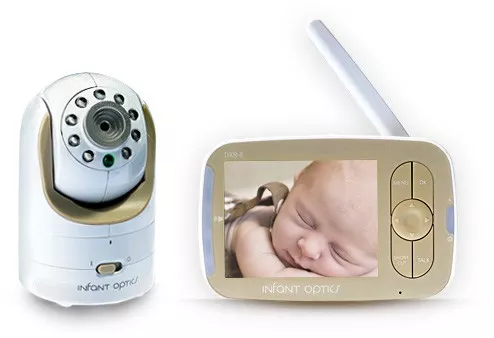

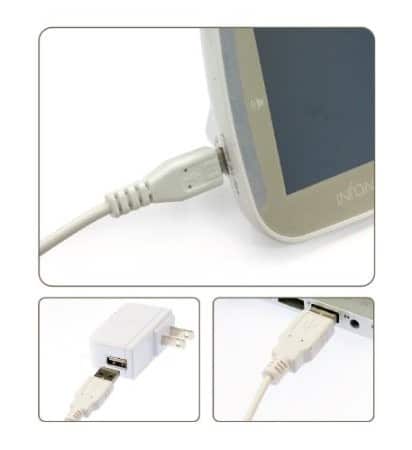
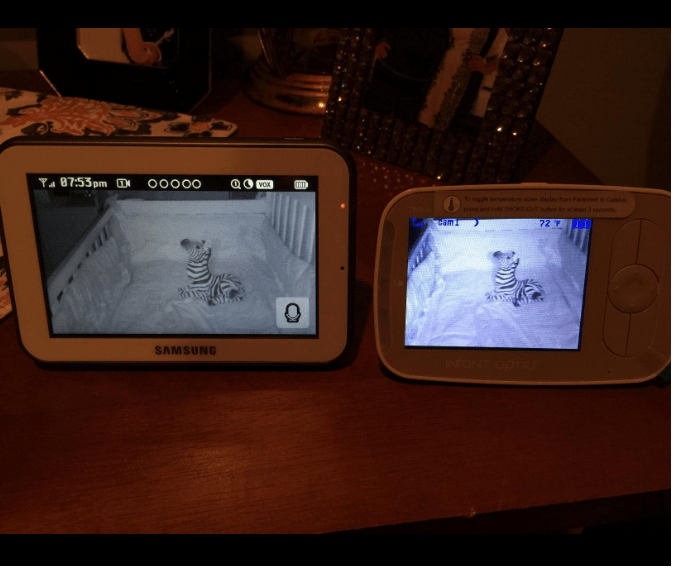
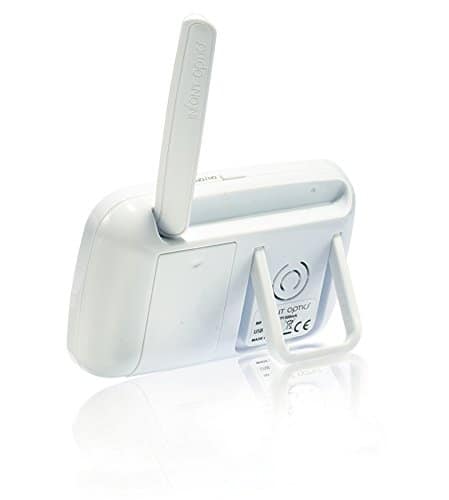
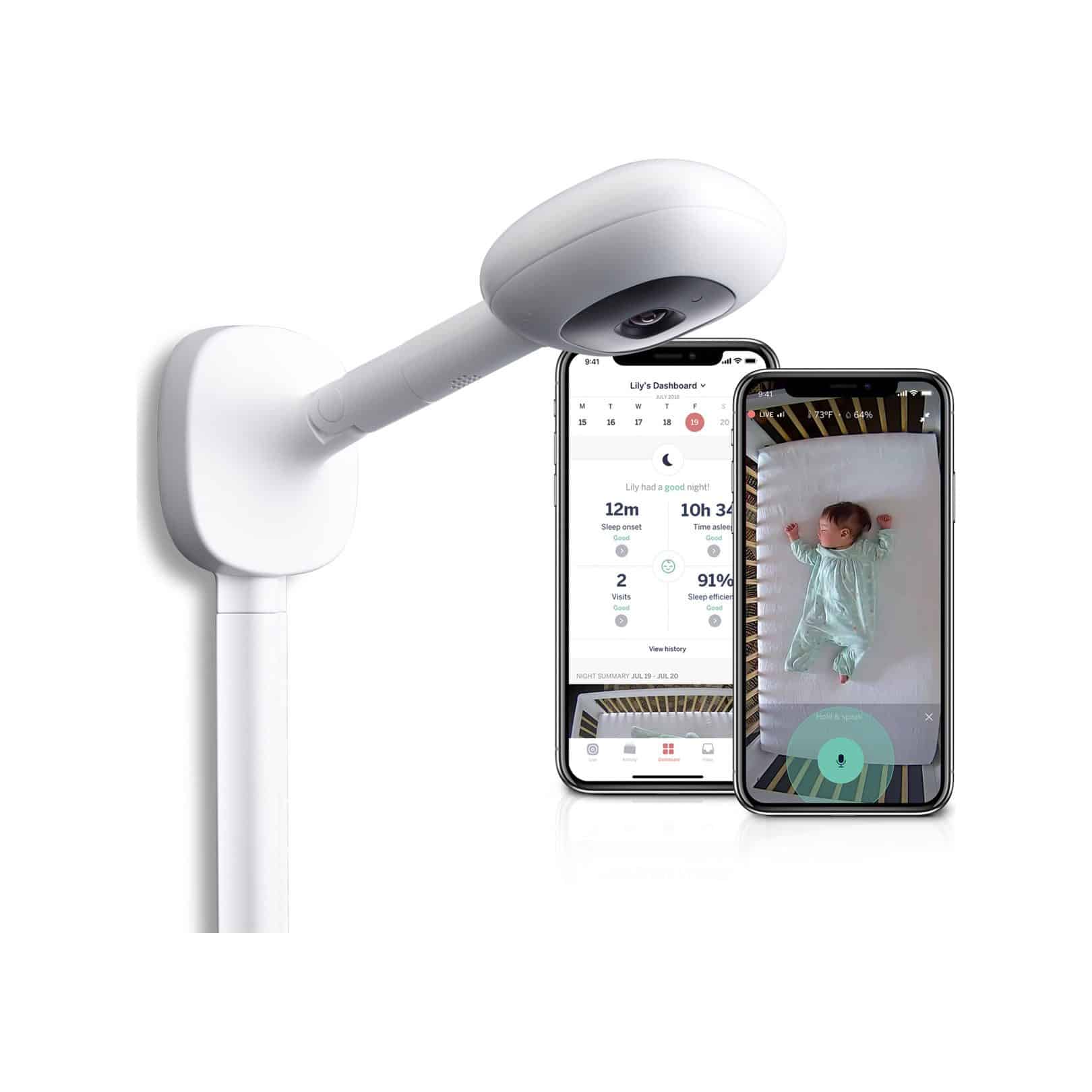

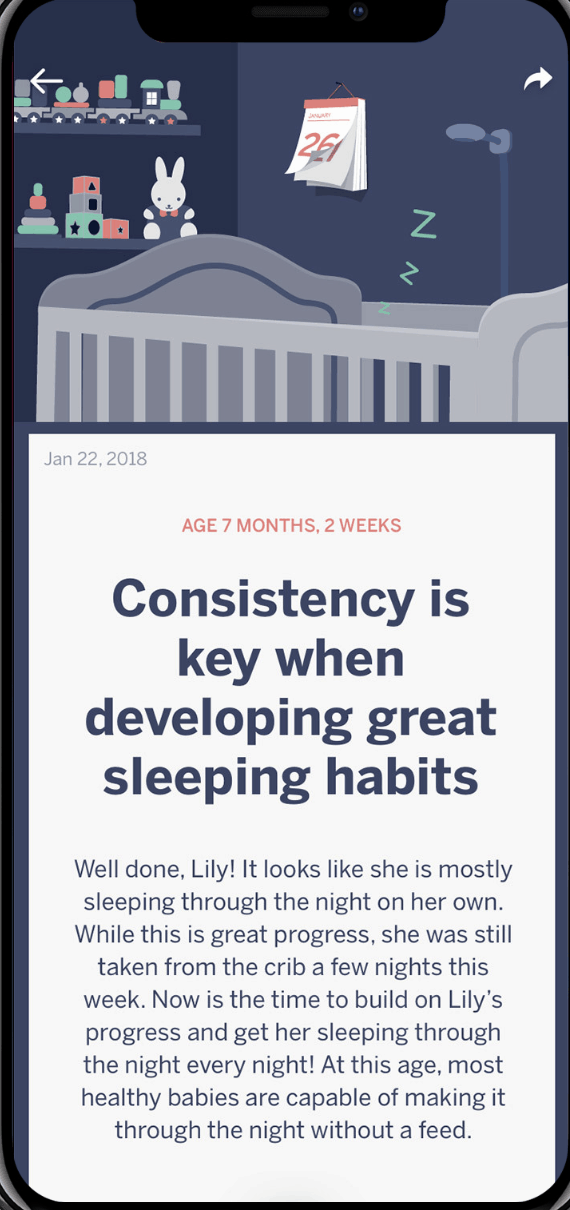
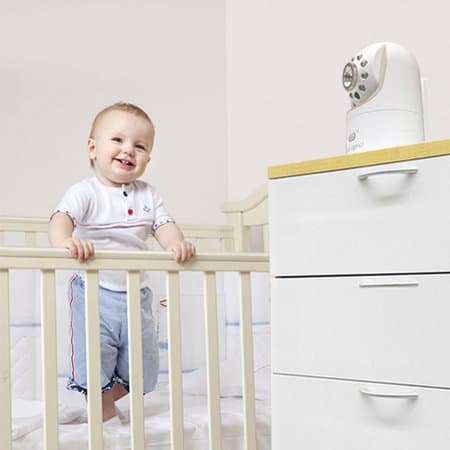

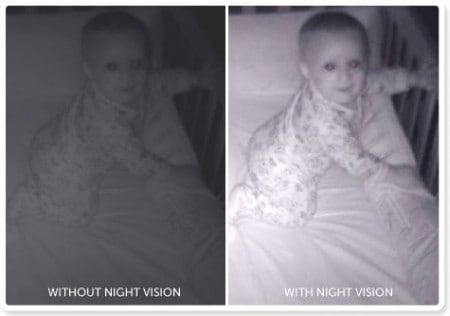
 We obsess over gear for families and the home . . . so you don’t have to. Baby Bargains has one mission: help you find the best gear for your family with unbiased reviews by experts with 20 years of experience. At prices that don’t break the bank. When you purchase a product from links on this site, we make a small affiliate commission. Learn more
We obsess over gear for families and the home . . . so you don’t have to. Baby Bargains has one mission: help you find the best gear for your family with unbiased reviews by experts with 20 years of experience. At prices that don’t break the bank. When you purchase a product from links on this site, we make a small affiliate commission. Learn more 

What do you think about the VAVA 720p 5” HD display video monitor? Several reviewers claim to like it even better that the Infant Optix DXR-8
Hi Amy: Well, our main concern with that monitor would be the large number of fake reviews posted for it (70% according to this estimate: https://reviewmeta.com/amazon/B07QGJQ775?utm_source=extension&utm_content=chrome_v2.4) We have not tested that one yet. Here is an article we wrote on Amazon with some additional monitor picks. I would suggest the eufy model, which is close to the VAVA in specs: https://www.amazon.com/ospublishing/story/81624273-ec21-42a1-9ce3-e02915d1ac1a Best wishes!
I’m a little confused. You mentioned the Eufy in your response to the other person and you link to an article where you seem to be picking it as the best… but you don’t mention it at all on here.
Which do you prefer, the Eufy or the Infant Optics?
The Eufy seems to be better in *almost* every way, although the Infant Optics obviously has a longer track record. Both are essentially the same price (167 vs 160).
Well, I’m glad you pointed that out! We have now split our video monitor reviews into 2 articles—one for affordable models and the other for high-end. That’s because there are many newer video monitors under $100, so they are now in a separate article here: https://www.babybargains.com/best-baby-monitor-with-camera-and-audio/
(We included the Eufy in there since it is about $150 . . . not super-affordable, but then again much less than the Nanit’s of the world!)
And high-end monitors are now here: https://www.babybargains.com/best-video-baby-monitor/
Hope that helps!
Thanks for the response, but it’s still very confusing…
Conceptually I understand separating “affordable” monitors from “high end” but I just don’t understand separating these two particular models that appear to be direct competitors into separate categories.
What makes the DXR-8 fall into the “high end” category but the Eufy is just an “upgrade” pick in the “affordable” category?
They are essentially right at the same price point.
The Infant Optics DXR-8 is $167 on Amazon and that seems to be about typical.
The Eufy Spaceview is $160 on Amazon, and that also looks to be about typical. There is currently a $30 coupon on Amazon for the Eufy but that is probably not typical.
About the Eufy you said “We’ve been testing baby monitors for 20 years and we can say this is one that just blew us away. It is light years ahead of others we’ve hand tested . . . but it is more pricey, unfortunately.” Based on the “more pricey” statement, it SEEMS like the rest of your thoughts here (“blew us away, ” “light years ahead,” etc.) are only relative to the other cheap-o monitors you had it compared against. But above that you said “If you have the budget and want the best monitor in terms of picture quality, range and battery life, here’s what we would pick after testing 8 different high-end monitors.” So there you essentially said that this really is a “high end” camera and doesn’t really belong in this category.
So it just really makes it hard for someone to compare these two models. It seems like you are picking the DXR-8 over the Eufy but it’s hard to figure out what your determining factors were. Both of them have their fair share of pros and cons, which you do outline separately, but there’s no “We picked _____ over _____ because _______” to pull it all together. For example, looking at your pros and cons you could have made either of these statements:
A. While the Eufy outperforms the DXR-8 in terms of picture and image quality, range, and battery life, we felt that the DXR-8 is acceptable enough in those areas that the long track record of quality and the addition of a visual clue to sound in the nursery tipped the scales in favor of the DXR-8.
B. While the DXR-8 has more than withstood the test of time (passing that test with flying colors) the Eufy’s strong performance in picture and image quality, range, and battery life are just too much to ignore. At least until longer-term test data becomes available,we are making the Eufy our #1 and the DXR-8 our number 2.
Those are obviously just two examples. Maybe your determining factor was something else entirely. Either way those are the sorts of insights that I was hoping to find here.
I know it’s controversial, but my wife and I really find the VOX feature to be essential. It looks like the Eufy on the other page (less expensive) has it. In your reviews, do you have any “runner-ups” that have VOX? We love our audio-only monitor, but can’t seem to find one that supports multiple rooms.